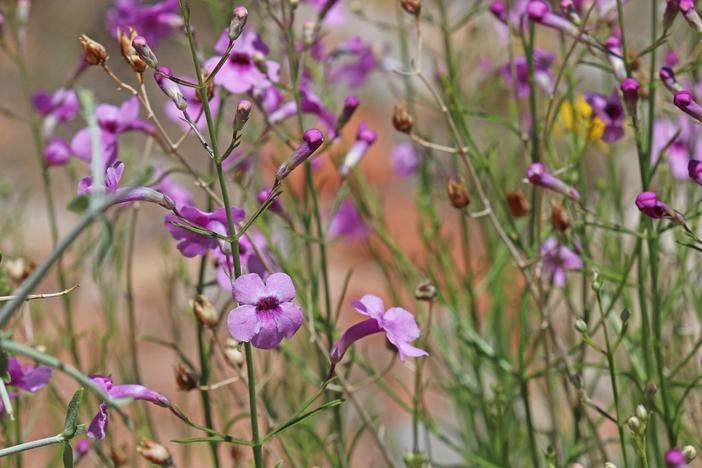Thurber’s Beardtongue
(Penstemon thurberi)
Thurber’s Beardtongue (Penstemon thurberi)
/
/

Andrey Zharkikh
CC BY 2.0
Image By:
Andrey Zharkikh
Recorded By:
Copyright:
CC BY 2.0
Copyright Notice:
Photo by: Andrey Zharkikh | License Type: CC BY 2.0 | License URL: https://creativecommons.org/licenses/by/2.0/ | Uploader: AndreyZharkikh | Publisher: Flickr



























Estimated Native Range
Summary
Penstemon thurberi, commonly known as Thurber’s beardtongue, is a perennial herb that is native to the desert scrub and open woodlands of the southwestern United States and Northern Mexico. It is a semi-deciduous plant that can grow erect and somewhat rounded in form, reaching around 80 centimeters in maximum height. Many slender stems emerge from its woody base, creating a bushy appearance. The leaves of Thurber’s beardtongue are narrow and linear, with edges rolled upward nearly into a tube, which is an adaptation to its arid native habitat. From late spring to early summer, the plant bears long inflorescences with showy funnel-shaped flowers that can be lavender, pink, or pale blue-purple, each up to 1.5 centimeters in length.
Thurber’s beardtongue is valued for its drought tolerance and its ability to thrive in challenging conditions, making it a suitable choice for xeriscaping and rock gardens. Its flowers are attractive to pollinators, including bees and hummingbirds, adding ecological value to the garden. In cultivation, it requires full sun exposure and well-drained soil, and it is adapted to low water conditions, reflecting its desert origins. While it is not commonly afflicted by diseases, overwatering can lead to root rot. It is not known to have aggressive roots or to be particularly invasive when grown outside its native range. However, gardeners should be mindful of its potential to spread if conditions are favorable.CC BY-SA 4.0
Thurber’s beardtongue is valued for its drought tolerance and its ability to thrive in challenging conditions, making it a suitable choice for xeriscaping and rock gardens. Its flowers are attractive to pollinators, including bees and hummingbirds, adding ecological value to the garden. In cultivation, it requires full sun exposure and well-drained soil, and it is adapted to low water conditions, reflecting its desert origins. While it is not commonly afflicted by diseases, overwatering can lead to root rot. It is not known to have aggressive roots or to be particularly invasive when grown outside its native range. However, gardeners should be mindful of its potential to spread if conditions are favorable.CC BY-SA 4.0
Plant Description
- Plant Type: Herb, Subshrub
- Height: 2-3 feet
- Width: 2-3 feet
- Growth Rate: Moderate
- Flower Color: Pink, Purple
- Flowering Season: Fall, Spring, Summer
- Leaf Retention: Deciduous
Growth Requirements
- Sun: Full Sun
- Water: Low
- Drainage: Medium
Common Uses
Bee Garden, Bird Garden, Butterfly Garden, Deer Resistant, Drought Tolerant, Hummingbird Garden, Low Maintenance, Rabbit Resistant, Showy Flowers
Natural Habitat
native to the desert scrub and open woodlands of the southwestern United States and Northern Mexico
Other Names
Common Names: Thurber’s Beardtongue
Scientific Names: , Penstemon thurberi, Penstemon thurberi var. anestius, Leiostemon thurberi, Penstemon scoparius, Penstemon ambiguus var. thurberi,
GBIF Accepted Name: Penstemon thurberi Torr.